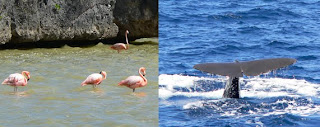Spotting exotic wildlife in its natural habitat
Original publication date: May 13, 2011 (Apologies for online publication delay. Had to wait for Blogger to come back online.)
As children, zoos and aquariums give us a glimpse into the lives of animals we are unlikely to ever see outside of enclosures. Today, the staff at respected facilities provide rehabilitation services, conduct important research and deliver outreach programs to raise awareness about conservation and respect for animals.
Sure, initially most of us visit zoos and aquariums for the entertainment value and they serve as major tourist draws. I'll never forget the first time I flew to Florida with my family. As much as I like animated flicks, for me the best part wasn't Disney's Magic Kingdom, but rather Epcot's 5.7 million gallon salt water aquarium where I could see underwater life up close.
When I was young, we used to trek to the Metro Toronto Zoo and drive through African Lion Safari. And as an adult, everytime I have traveled to Southern California I would stay on to explore the outstanding San Diego Zoo again. If my travels were within Canada, then I would go to Stanley Park where my sister led dedicated teams of volunteers at the Vancouver Aquarium.
So imagine my delight the first time I saw parrots outside of enclosures. How about penguins, whales, flamingos, sharks, monkeys or dolphins?
Seeing any exotic species out in the open seas, a desert or a lush forest takes my breath away and reminds me how fortunate we are to share this planet with creatures that are so
AWESOME!
As children, zoos and aquariums give us a glimpse into the lives of animals we are unlikely to ever see outside of enclosures. Today, the staff at respected facilities provide rehabilitation services, conduct important research and deliver outreach programs to raise awareness about conservation and respect for animals.
Sure, initially most of us visit zoos and aquariums for the entertainment value and they serve as major tourist draws. I'll never forget the first time I flew to Florida with my family. As much as I like animated flicks, for me the best part wasn't Disney's Magic Kingdom, but rather Epcot's 5.7 million gallon salt water aquarium where I could see underwater life up close.
When I was young, we used to trek to the Metro Toronto Zoo and drive through African Lion Safari. And as an adult, everytime I have traveled to Southern California I would stay on to explore the outstanding San Diego Zoo again. If my travels were within Canada, then I would go to Stanley Park where my sister led dedicated teams of volunteers at the Vancouver Aquarium.
So imagine my delight the first time I saw parrots outside of enclosures. How about penguins, whales, flamingos, sharks, monkeys or dolphins?
Seeing any exotic species out in the open seas, a desert or a lush forest takes my breath away and reminds me how fortunate we are to share this planet with creatures that are so
AWESOME!
My March 2011 sightings: wild flamingos in Bonaire
and a sperm whale in Dominica.



Comments
Post a Comment